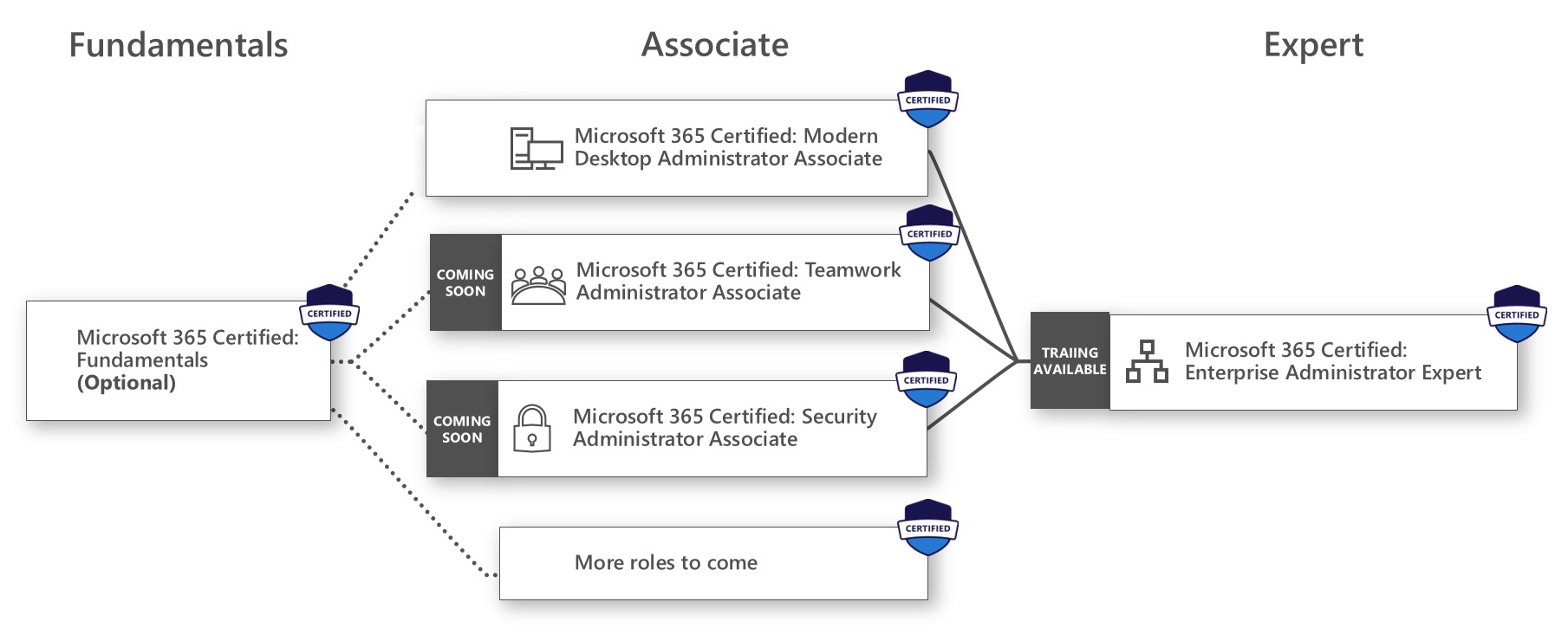
MCE Microsoft 365 Administrator Expert w/MCA Microsoft 365 Endpoint Administrator Accelerated COMBO Certification Camp (2 Courses, 2 Exams, 2 Certs)
$4,995.00
This Microsoft Official Boot Camp is an end-to-end training and certification program for Microsoft 365 Endpoint Administrator Associate and Microsoft 365 Administrator Expert. The MCE certification requires the MCA prerequisite. Career Camps exclusively offers this 6 day Microsoft Official Accelerated Combo Boot Camp where students advance their skills and test to achieve certification while attending.
Students learn how to deploy, configure, protect, manage, monitor services, devices and client applications in a Microsoft 365 environment. They manage identity, security, access, policies, updates, and apps for endpoints. They implement and manage endpoints using Microsoft Intune, Windows 365, Windows Autopilot, Microsoft Defender for Endpoint, and Azure Active Directory (Azure AD), part of Microsoft Entra.
EXAMS INCLUDED
MD-102: Endpoint Administrator
MS-102: Microsoft 365 Administrator
WHAT IS INCLUDED
| Airfare to/from Sarasota, FL | |
| 6 Nights of Lodging | |
| Ground Transportation | |
| Microsoft Training Books | |
| 2 Microsoft Exam Vouchers | |
| 1 Retake Voucher (per exam, if needed) | |
| Onsite Pearson Vue Test Center | |
| Microsoft Study Labs & Simulations |
LOCATIONS
Career Camps primary Microsoft Training campus (for individual students) is located in Sarasota, FL. Can’t travel to our facility? No problem! You will save on airfare, lodging and transportation. Just contact us and we will get you pricing to attend the class online live virtually from your work or home. If you do not see the location or class you are looking for, let us know! We have access to hundreds of classes and locations all across the United States and also offer corporate and group rates. If you have 5 students or more we can even come to you! With several partnerships in place, we are sure to have something to fit your needs. Whether you need to get MCA or MCE Certified, or get updated on Microsoft Windows Server 2022, we’ve got you covered.
Description
While attending this 6 day camp – students take two exams MD-102 Endpoint Administrator and MS-102 Microsoft 365 Administrator to achieve the Microsoft MCA & MCE Official Certifications.
The Microsoft 365 Certified MCA/MCE combo boot camp is taught using TWO Microsoft Official Courseware Courses –
MD-102T00: Microsoft 365 Endpoint Administrator
MS-102T00: Microsoft 365 Administrator Essentials
Topics Covered in this Official Boot Camp:
Explore the Enterprise Desktop
Describe the benefits of Modern Management.
Explain the enterprise desktop life-cycle model.
Describe considerations for planning hardware strategies.
Describe considerations for post-deployment and retirement.
Examine the enterprise desktop life-cycle model
Examine planning and purchasing
Examine desktop deployment
Plan an application deployment
Plan for upgrades and retirement
Explore Windows Editions
Explain the differences between the different editions of Windows.
Select the most suitable Windows device for your needs.
Describe the minimum recommended hardware requirements for installing Windows 11
Examine Windows client editions and capabilities
Select client edition
Examine hardware requirements
Understand Microsoft Entra ID
Describe Microsoft Entra ID.
Compare Microsoft Entra ID to Active Directory Domain Services (AD DS).
Describe how Microsoft Entra ID is used as a directory for cloud apps.
Describe Microsoft Entra ID P1 and P2.
Describe Microsoft Entra Domain Services.
Examine Microsoft Entra ID
Compare Microsoft Entra ID and Active Directory Domain Services
Examine Microsoft Entra ID as a directory service for cloud apps
Compare Microsoft Entra ID P1 and P2 plans
Examine Microsoft Entra Domain Services
Manage Microsoft Entra identities
Describe RBAC and user roles in Microsoft Entra ID.
Create and manage users in Microsoft Entra ID.
Create and manage groups in Microsoft Entra ID.
Use Windows PowerShell cmdlets to manage Microsoft Entra ID.
Describe how you can synchronize objects from AD DS to Microsoft Entra ID.
Examine RBAC and user roles in Microsoft Entra ID
Create and manage users in Microsoft Entra ID
Create and manage groups in Microsoft Entra ID
Manage Microsoft Entra objects with Microsoft Graph PowerShell
Synchronize objects from AD DS to Microsoft Entra ID
Manage device authentication
Describe Microsoft Entra join.
Describe Microsoft Entra join prerequisites, limitations, and benefits.
Join device to Microsoft Entra ID.
Manage devices joined to Microsoft Entra ID.
Describe Microsoft Entra join
Examine Microsoft Entra join prerequisites limitations and benefits
Join devices to Microsoft Entra ID
Manage devices joined to Microsoft Entra ID
Enroll devices using Microsoft Configuration Manager
Describe Microsoft Endpoint Manager.
Understand the advantages of managing a client with Configuration Manager.
Deploy the Configuration Manager client.
Monitor the Configuration Manager client.
Manage Configuration Manager devices.
Deploy the Microsoft Configuration Manager client
Monitor the Microsoft Configuration Manager client
Manage the Microsoft Configuration Manager client
Enroll devices using Microsoft Intune
Prepare Microsoft Intune for device enrollment.
Configure Microsoft Intune for automatic enrollment.
Explain how to enroll Windows, Android, and iOS devices in Intune.
Explain when and how to use Intune Enrollment Manager.
Understand how to monitor and perform remote actions on enrolled devices.
Manage mobile devices with Intune
Enable mobile device management
Explain considerations for device enrollment
Manage corporate enrollment policy
Enroll Windows devices in Intune
Enroll Android devices in Intune
Enroll iOS devices in Intune
Explore device enrollment manager
Monitor device enrollment
Manage devices remotely
Execute, oversee, maintain device profiles
Describe the various types of device profiles in Intune.
Explain the difference between built-in and custom profiles.
Create and manage profiles.
Explore Intune device profiles
Create device profiles
Create a custom device profile
Monitor device profiles in Intune
Manage device sync in Intune
Manage devices in Intune using scripts
Examine user profile
Explore user profile types
Examine options for minimizing user profile size
Deploy and configure folder redirection
Sync user state with Enterprise State Roaming
Configure Enterprise State Roaming in Azure
Execute mobile application management
Explain Mobile Application Management.
Understand application considerations in MAM.
Explain how to use Configuration Manager for MAM.
Use Intune for MAM.
Implement and manage MAM policies.
Examine mobile application management
Examine considerations for mobile application management
Prepare line-of-business apps for app protection policies
Implement mobile application management policies in Intune
Manage mobile application management policies in Intune
Deploy and update applications
Explain how to deploy applications using Intune and Configuration Manager.
Learn how to deploy applications using Group Policy.
Understand Microsoft Store Apps.
Learn how to deploy apps using Microsoft Store Apps.
Learn how to configure Microsoft Store Apps.
Deploy applications with Intune
Add apps to Intune
Manage Win32 apps with Intune
Deploy applications with Configuration Manager
Deploying applications with Group Policy
Assign and publish software
Explore Microsoft Store for Business
Implement Microsoft Store Apps
Update Microsoft Store Apps with Intune
Assign apps to company employees
Administer endpoint applications
Explain how to manage apps in Intune.
Understand how to manage apps on nonenrolled devices.
Understand how to deploy Microsoft 365 Apps using Intune.
Learn how to configure and manage IE mode in Microsoft Edge.
Learn about app inventory options in Intune.
Manage apps with Intune
Manage Apps on non-enrolled devices
Deploy Microsoft 365 Apps with Intune
Additional Microsoft 365 Apps Deployment Tools
Configure Microsoft Edge Internet Explorer mode
App Inventory Review
Protect identities in Microsoft Entra ID
Describe Windows Hello for Business
Describe Windows Hello deployment and management
Describe Microsoft Entra ID Protection
Describe and manage self-service password reset in Microsoft Entra ID
Describe and manage multi-factor authentication
Explore Windows Hello for Business
Deploy Windows Hello
Manage Windows Hello for Business
Explore Microsoft Entra ID Protection
Manage self-service password reset in Microsoft Entra ID
Implement multi-factor authentication
Enable organizational access
Describe how you can access corporate resources
Describe VPN types and configuration
Describe Always On VPN
Describe how to configure Always On VPN
Enable access to organization resources
Explore VPN types and configuration
Explore Always On VPN
Deploy Always On VPN
Implement device compliance
Describe device compliance policy
Deploy a device compliance policy
Describe conditional access
Create conditional access policies
Protect access to resources using Intune
Explore device compliance policy
Deploy a device compliance policy
Explore conditional access
Create conditional access policies
Generate inventory and compliance reports
Generate inventory reports and Compliance reports using Microsoft Intune
Report and monitor device compliance
Create custom reports using the Intune Data Warehouse
Use the Microsoft Graph API for building custom reports
Report enrolled devices inventory in Intune
Monitor and report device compliance
Build custom Intune inventory reports
Access Intune using Microsoft Graph API
Deploy device data protection
Describe Windows Information Protection
Plan for Windows Information Protection usage
Implement and use Windows Information Protection
Describe the Encrypting File System (EFS)
Describe BitLocker
Explore Windows Information Protection
Plan Windows Information Protection
Implement and use Windows Information Protection
Explore Encrypting File System in Windows client
Explore BitLocker
Manage Microsoft Defender for Endpoint, Windows Client & Cloud Apps
Describe Microsoft Defender for Endpoint.
Describe key capabilities of Microsoft Defender for Endpoint.
Describe Microsoft Defender Application Guard.
Describe Microsoft Defender Exploit Guard.
Describe Windows Defender System Guard.
Explore Microsoft Defender for Endpoint
Examine key capabilities of Microsoft Defender for Endpoint
Explore Windows Defender Application Control and Device Guard
Explore Microsoft Defender Application Guard
Examine Windows Defender Exploit Guard
Explore Windows Defender System Guard
Explore Windows Security Center
Explore Windows Defender Credential Guard
Manage Microsoft Defender Antivirus
Manage Windows Defender Firewall
Explore Windows Defender Firewall with Advanced Security
Explore Microsoft Defender for Cloud Apps
Planning Microsoft Defender for Cloud Apps
Implement Microsoft Defender for Cloud Apps
Assess deployment readiness
Describe the guidelines for an effective enterprise desktop deployment.
Explain how to assess the current environment.
Describe the tools that you can use to assess your current environment.
Describe the methods of identifying and mitigating application compatibility issues.
Explain considerations for planning a phased rollout.
Examine deployment guidelines
Explore readiness tools
Assess application compatibility
Explore tools for application compatibility mitigation
Prepare network and directory for deployment
Plan a pilot
Deploy using the Microsoft Deployment Toolkit, Configuration Manager & Windows Autopilot
Describe the fundamentals of using images in traditional deployment methods.
Describe the key benefits, limitations, and decisions when planning a deployment of – Windows using Microsoft Deployment Toolkit (MDT).
Describe how Configuration Manager builds upon MDT and how both can work in harmony.
Explain the different options and considerations when choosing the user interaction experience during deployment, and which methods and tools support these experiences.
Evaluate traditional deployment methods
Set up the Microsoft Deployment Toolkit for client deployment
Manage and deploy images using the Microsoft Deployment Toolkit
Explore client deployment using Configuration Manager
Examine deployment components of Configuration Manager
Manage client deployment using Configuration Manager
Plan in-place upgrades using Configuration Manager
Use Autopilot for modern deployment
Examine requirements for Windows Autopilot
Prepare device IDs for Autopilot
Implement device registration and out-of-the-box customization
Examine Autopilot scenarios
Troubleshoot Windows Autopilot
Implement dynamic deployment methods
Describe how Subscription Activation works.
Describe the benefits of Provisioning Packages.
Explain how Windows Configuration Designer creates Provisioning Packages.
Describe the benefits of using MDM enrollment with Microsoft Entra join.
Examine subscription activation
Deploy using provisioning packages
Use Windows Configuration Designer
Use Microsoft Entra join with automatic MDM enrollment
Plan a transition to modern endpoint management
Identify usage scenarios for Microsoft Entra join.
Identify workloads that you can transition to Intune.
Identify prerequisites for co-management.
Identify considerations for transitioning to modern management.
Plan a transition to modern management using existing technologies.
Plan a transition to modern management using Microsoft Intune.
Explore using co-management to transition to modern endpoint management
Examine prerequisites for co-management
Evaluate modern management considerations
Evaluate upgrades and migrations in modern transitioning
Migrate data when modern transitioning
Migrate workloads when modern transitioning
Manage Windows 365 & Azure Virtual Desktop
Describe the key features of Windows 365.
Describe the Windows 365 management experience.
Describe the Windows 365 security model.
Describe the Windows 365 deployment options.
Describe the Windows 365 licensing model.
Explore Windows 365
Configure Windows 365
Administer Windows 365
Describe the key features of Azure Virtual Desktop
Describe the Azure Virtual Desktop management experience
Describe the Azure Virtual Desktop security model
Describe the Azure Virtual Desktop deployment options
Examine Azure Virtual Desktop
Explore Azure Virtual Desktop
Configure Azure Virtual Desktop
Administer Azure Virtual Desktop
Additional information
| Class Dates | 07/28/2025 – 08/02/2025 – Sarasota, FL, 08/25/2025 – 08/30/2025 – Sarasota, FL, 09/29/2025 – 10/04/2025 – Sarasota, FL, 10/27/2025 – 11/01/2025 – Sarasota, FL, 11/17/2025 – 11/22/2025 – Sarasota, FL |
|---|
Our Facilities
CAREER CAMPS FACILITIES

CLASSROOM EQUIPMENT – Students work on a dedicated Dell Client Desktop with 32GB memory with 512GB SSD drives – All Labs are executed the extremely fast Microsoft Data Center Hosted Lab Environment.
CAMPUS INTERNET – The campus is connected with a 1Gbps (1,000 Mbps) Verizon Fios Business Connection which provides complete internet (including VPN) access for students.
COMMON AREA – Amenities including snacks, drinks (Coffee, 100% juices, sodas, etc) all complimentary.
LODGING – We use the Hyatt Place Lakewood Ranch. This “upgraded” hotel offers extremely comfortable beds, great breakfast and very fast internet access.
NEAR BY AMENITIES – Many shops, restaurants and grocery options are available within walking distance. Additionally – the hotel provided scheduled shuttle services. Restaurants like Bone Fish Grill, Ruby Tuesday’s, Five Guys, Chipotle, Quiznos, Chili’s and over 20 additional choices in the immediate area. All of these options are offered in a pedestrian walking village.
Why Choose Us
CAREER CAMPS DIFFERENCE
Career Camps provides an in-depth hands on learning environment. Our instructors teach using demonstrations and explain concepts beyond the scope of the courseware. The best instructors are contracted from all across the US. These professionals are real world consultants who actually implement these technologies. Career Camps knows our clients work in the “real world” and it only makes sense to have an instructor with the experience in the real world.
Facilities – Many of our competitors over-crowd classrooms by placing 2 to 3 students per desk and 20+ students per instructor. Often these companies “extend” the life of very old equipment with slow performance on the software used today. Our average class size is 8 students. Our facilities have the best equipment with the most comfortable, focused environment for learning.
Instructors – Our CEO, Chester Flake holds one of the rarest Microsoft Certifications – the Microsoft Certified Learning Consultant (MCLC) Certification. This certification reflects a commitment to make sure our instructors are also actively engaged in real world consulting projects. Students expect a professional who can answer questions and demonstrate the technology.
Face to Face Training – We believe the best way to interact and learn is face to face training. Many of our competitors which offer local training are simply providing students with headphones/mic to attend class with an instructor at a remote location.
Test Pass – We offer a free retake voucher (if needed) for each of the exams required for certification. Any training center offering a “100% pass guarantee” would have to use unethical practices or unlimited test vouchers (which is not likely or practical).
Distractions – Students often look for a “local” training center so they can be close to home and work. Boot camp requires a tremendous time commitment during the program. Long class hours combined with self study each evening. The goal of boot camp is to achieve certification in a fraction of the time. We strongly recommend students attend camp away from home and work in a focused, distraction free environment.
Boot Camp – Boot camp is an accelerated training focused on teaching technology and testing students on the official exams. Most training providers “added” boot camps to the existing standard training classes they offer. These training centers think a boot camp is just a regular class where you send the student home with a voucher on the last day. Career Camps administers exams throughout the camp. Equally important – not every trainer can teach a boot camp and not all courseware is designed for boot camp format. Our trainers know the boot camp format and our courseware is designed for accelerated learning.
Florida – Career Camps has one of the most scenic locations boasting some of the best weather in US. We believe students should have a comfortable and inviting atmosphere while attending these otherwise intense programs. We place our location, facilities and amenities up against that any competitor.
Microsoft 365 Roadmap
Microsoft 365 Training & Certification Roadmap
You May Also Like:
Related products
-
MCA Microsoft 365 Endpoint Administrator Associate w/Microsoft 365 Foundations Certification Camp (2 Courses 2 Exams 2 Certifications)
$3,995.00 Select options This product has multiple variants. The options may be chosen on the product page -
MCE Microsoft 365 Administrator Expert Certification Camp (1 Course, 1 Exam, 1 Certification)
$2,995.00 Select options This product has multiple variants. The options may be chosen on the product page -
MCA Microsoft Teams Administrator Associate Certification Camp (1 Course, 1 Exam, 1 Cert)
$2,495.00 Select options This product has multiple variants. The options may be chosen on the product page -
MCA Microsoft Azure Admin (w/ Foundations) + MCE Solutions Architect COMBO Certification Camp (3 Courses, 3 Exams, 3 Certifications)
$5,995.00 Select options This product has multiple variants. The options may be chosen on the product page





